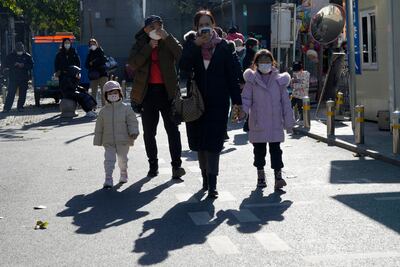Reports that large numbers of children in parts of northern China are suffering from respiratory illnesses have raised concerns over the seriousness of the situation.
Paediatric hospitals have reportedly been overwhelmed by cases of what has been described as an undiagnosed form of pneumonia.
The World Health Organisation has requested “detailed information” about the illnesses and state-run media has acknowledged overcrowding in children's hospitals during a "high incidence of infectious diseases".
But while the information so far is limited, experts outside China have cautioned against an overreaction.
Winter spike
"It’s early days and I’m reasonably comfortable," said Dr Bharat Pankhania, a senior consultant on communicable disease control and senior clinical lecturer at the University of Exeter.
"It’s a chest infection, seasonal, as we enter winter in the Northern Hemisphere. It wouldn’t surprise me if there are cases."

In many parts of the world, cases of respiratory illnesses including influenza and colds peak in the winter because people spend more time indoors around others, making it easier for pathogens to spread. Johns Hopkins Medicine says cold, dry air may also be a factor in the increase in such cases.
"It’s most likely that this will blow over and will just be a higher rate than normal of winter seasonal diseases," said Paul Digard, professor of virology at the University of Edinburgh.
"I’m not ringing any alarm bells at this point. There’s not enough information to decide whether it’s important or not, but it's definitely worth keeping an eye on."
Immunity levels affected by Covid-19
After Covid-19 emerged, China had one of the longest and strictest lockdowns in the world, with restrictions only lifted in December 2022.
There was limited social mixing between people for nearly three years, so there have been fewer respiratory infections. As a result, immunity levels may have dropped, which may be why infection rates are now higher than average.
"Following lockdown they probably have low natural immunity and [infections have] flared up," said Ian Jones, professor of virology at the University of Reading.
"As far as I know, there have been no deaths, so it’s controllable and treatable. It’s a local outbreak. I don’t think it’s anything we should be particularly concerned about."

The news from China has led to an increase in concern because of possible parallels with the start of the pandemic, when the WHO was informed of cases of a respiratory illness in the city of Wuhan.
These were the first cases of Covid-19, which upended life around the globe and has killed about seven million people, official figures show.
The origins of SARS-CoV-2 remain unknown, with the two key alternatives being a virus that crossed the species barrier from wild animals to people, or a virus that escaped from a laboratory.
Surge in infections
Amid the latest surge in illness, China’s National Health Commission has said that there has been an increase in Covid-19, influenza and mycoplasma, a bacterial infection.
Prof Paul Hunter, an infectious diseases researcher at the University of East Anglia, said the infections were unlikely to have been caused by a new pathogen.
"If it was, I would expect to see a lot of older people [infected]. The fact it isn’t suggests adults are already immune to it, so it’s something they’ve experienced before," he said.
"The fact it seems to have appeared in multiple places at the same time also suggests it's not a point-source pandemic like we saw with Covid."
Prof Hunter said the information released so far indicated that the infections presented primarily as a fever, with some patients also having lung or pulmonary nodules.
"Pulmonary nodules tend to suggest bacterial infections rather than viral infections, although you can see them with influenza," Prof Hunter said.
While the world may still be on edge about the threat of a new pathogen emerging, Prof Jones said it was no more probable now, in the wake of the Covid-19 pandemic, than in 10 or 20 years.
"Just because it’s pneumonia and it’s China, it doesn’t mean there should be a particular cause for alarm," he said.
A virus called SARS-CoV-1, which caused the 2002 to 2004 outbreak of severe acute respiratory system [Sars], emerged in China, just as SARS-CoV-2 did.
Markets in Guangdong province, in southern China, were linked to the outbreak, with a virus that infected wild animals sold as food having potentially crossed the species barrier and started to infect people.
Dr Pankhania said the probability of a new virus or bacterium emerging "always increases in places where biosecurity is not 100 per cent".
But he said similar issues were found in other nations and there was no particular reason to expect the next pandemic to emerge from China.
"Where you have a lot of proximity of birds, other animals and humans, there’s a potential to generate a reassorted virus. All of this applies to many countries in the Far East," he said.

